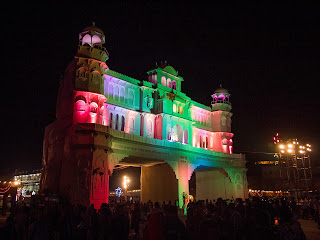And now I’m scribbling into my notebook in a smoky hotel bar
by the railway station at the end of the day in Jaipur, the “pink city” and the
capital of Rajasthan. Delhi Belly has
finally done its wretched dance in my stomach and I’ve been taking the day with
simple steps and simple food. Peanuts
and bananas. Cuisine much to the liking
of any of the thousands of monkeys overlooking their glowing city from their
hill cresting Galta Temple.
Oh Jaipur. The colors
of your barren landscape remind me so oddly of those in Southern California,
with your salty palette of almond, olive, and cashew… but it’s what sets you
apart, your famously pink and well preserved Rajasthani charm, that I’m so in
love with. Whereas some of the temples
and palaces of the India I’ve seen so far seem as if mummified fragments of
cities past, now shoddily paved over, Jaipur is old and yet still very much
alive. The architecture of the markets,
full of pashmina, bangles, and mobile phone stalls, blend seamlessly with the
city’s monumental minarets and kaleidoscope palaces.
Jaipur’s past masters must have loved showing off, and
thanks to their ostentatious sensibilities we have places like Jantar Mantar,
Maharaja Jai Singh’s love letter to the cosmos.
It is a sculpture garden of beguiling angles and proportions and each
gargantuan disc, orb, and step ladder is a functional astronomical instrument,
measuring the movements of celestial bodies and ourselves in the always moving
universe, all with a baffling precision that still holds up today.
Or take Jal Mahal, the impossible palace floating in the
middle of a lake, so the royalty might enjoy the company of their mistresses
with greater privacy (the same was said of the Hawa Mahal and Nahargarh Fort –
the Maharajas sure had a lot of love to give).
Overwhelming is a word I’m perhaps using too abundantly, but
too often it’s been the right word. Such
as the moment after my rickshaw curved around a mountain bend, right past
elephants and their riders, and the sweeping fortifications of Amber Fortress
slap you right in the face. Birds fill
the sky, and on the ground – the very ground you’re walking on – villagers are
kneading and hawking some kind of doughy confectionary I abstained from trying. Squat toilets used by kings still remain (and
somehow the odor does as well), as well as engineering marvels like the massive
system of wheels and cylinders that helped pull water from the roadside to the
fortress’s reservoirs.
My timing in Jaipur was very deliberate and the result of my
googling, “best city India Diwali.”
Every year, Jaipur’s many bazaars compete to boast the most spectacular
Diwali light displays. Think Christmas
meets 4th of July, but flavored with curry. By day the roadsides are full of sugarcane,
marigold, and candy gift boxes, and when the sun – Jaipur’s ruby red good luck
tika – gets washed away by the night, each street erupts in bulbous streams of
every color set to the revelry of firecrackers and noisemakers.
I stayed with Stefani, a Chicago native working for an NGO,
generously dedicating her time to rebuilding part of the state’s grade school
curriculum. Near her home, I had to be under
the careful guise of her cousin, as her landlord is very suspicious about the
goings on of a young single woman and imposes a strict curfew. On Diwali’s most important night, the third
night of five, we joined a terribly sweet local family’s celebration. Prayers were said over marigolds and the purifying
smoke of incense before the indulgence of a homemade Indian feast and
fireworks. I had a rather good Indian
whiskey and too many cashew pastries coated with some kind of edible silver
material. There were four children
running around with sparklers, bombs, and toy guns, and a wave of memories from
my own childhood poured into my present. I could see fragments of the past, mental
pictures that haven’t been pulled out in years, the wooden fences and cement
patios of long forgotten backyards. I drank
koolaid and ran away from spinners and my parents were so much bigger
then. The night was another mix of the
familiar and the exotic. I couldn’t
thank the family enough for sharing their holiday with a stranger.
Before leaving the states, I had decided to put off getting Typhoid
shots and anti-malaria pills. My timing
in India was such that those diseases are taking a break, but somewhere in my
near future, Myanmar waits for me, and I do want to be better armed against the
country’s particularly resistant strains of malaria. In New York, I likely would have had to pay
about $300 for typhoid immunizations and the related consultation. Anti-Malarials would probably be another
hundred or so on top. In India, after
maybe an hour long visit to a very clean and friendly hospital in Jaipur, I got
my Typhoid immunization and Anti-Malarials for roughly 12 USD.
The trip to the hospital went much smoother than I had been
expecting, but with one important exception.
I had to use the toilet, but I had left my day bag at my host’s
apartment. That means I didn’t have
toilet paper. I don’t know if you know
this, but Asian natives don’t use toilet paper.
An Asian latrine typically consists of a hole in the ground, a low lying
faucet, and a plastic bucket. And no
instruction manual. So my visit to the
hospital was both an economically laudable decision and a unique cultural
experience.






2 comments:
Post a Comment